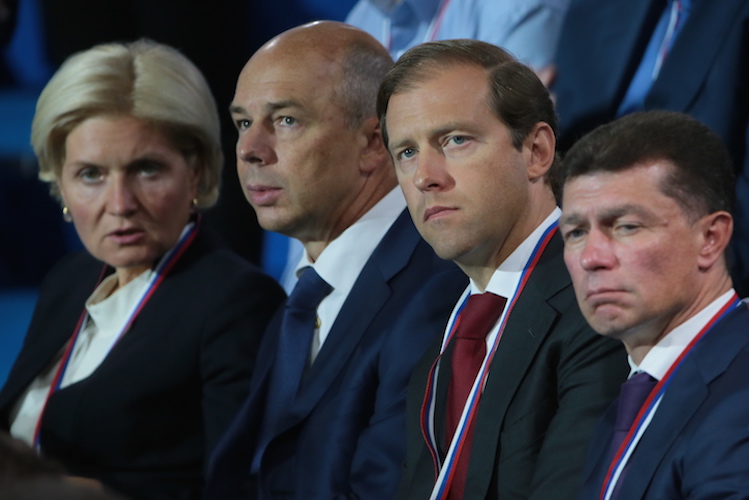In his latest comment on key developments impacting the Russian economy, Sergey Aleksashenko, nonresident senior fellow at the Brookings Institution and former deputy chairman of the Russian Central Bank, reviews the government’s controversial efforts to battle the economic crisis.

Left to right: Russia's deputy prime minister Olga Golodets, finance minister Anton Siluanov, industry and trade minister Denis Manturov, labor minister Maxim Topilin. Photo: Mikhail Metzel / TASS
Unnecessary Government?
Today, it seems the Russian government itself no longer believes the economy can begin growing unless oil prices rise again. Nor does the government understand what it needs to do to boost the economy.
Last fall’s upbeat rhetoric claiming that the crisis had peaked and the economy had started to recover is now replaced by the far less optimistic statements of finance minister Anton Siluanov, who has said that Russia’s economic troubles are serious and will be sticking around. If you’re wondering why, the minister has a short answer for you: oil prices. They won’t be bouncing back any time soon.
His words are echoed in the statements of labor minister Maksim Topilin, who “reassured” the Russian households that this year they can expect real wages to fall just a little bit—by 3 to 4 percent—dropping to early 2008 levels.
On the one hand, it’s good that the ministers are taking a realistic view of the situation and can soberly judge their own capabilities. But on the other hand, if the government cannot offer a solution to the crisis (or do anything at all), wouldn’t it be better to dissolve it? Then at least we’d see some budget savings.
Shortcomings of the Anti-crisis Plan
The government was still working on its anti-crisis plan, which hasn’t been published , though its key provisions are already clear.
First, the plan does not include even minimal fiscal stimulus for boosting economic growth. The plan’s whole focus is procyclical—in other words, its implementation will only exacerbate the economic downturn. In response to decreasing household consumption, the plan suggests increasing gasoline taxes. In response to dropping investments, it suggests that state companies should pay higher dividends to the federal budget.
Based on this, one can only conclude that the government has observed the slow downslide of the economy, and does not envisage it as a threat.
Second, the finance minister recently stated that even if oil is priced at $30 per barrel, the federal budget deficit will not exceed 4 percent of GDP. This shows that the government is more concerned with technicalities than with actual results. If other economic parameters remain unchanged and the ruble should drop to 90/1$ (an 18-percent hike), the minister’s goal can be achieved, but this “target” is clearly unacceptable to the Central Bank. Today, the demand and supply of foreign currency is balanced at the current ruble-dollar rate (about 74/1$).
It seems Russia is planning to reenact the European Union’s fiscal consolidation that occurred in 2009-2011. This policy significantly delayed Europe’s recovery after the global economic crisis. Can Russia have a different outcome? We will soon see.
Third, it looks like at the moment, Russia’s ministers are mostly focusing on coordinating the terms of the budget’s current spending cuts, which would help save about half a trillion rubles. With the announced 10-percent cut in expenditures, this means about one third of budget spending will subjected to cuts, while two thirds will remain untouched. The flipside of this process is the negotiation process about how the released money should be redistributed.
Incoherent Policy
I’ve already criticized the resolution policy to rescue failed banks through the injection of Central bank’s money and allocation of federal budget. (The Central Bank issues a loan to the Deposit Insurance Agency, which then issues a loan to the bridge banks; they, in turn, purchase federal T-bonds from the finance ministry, and the latter pays interest on them for the next 10 to 15 years.) Ultimately, this means that the government compensates the losses of clients of some failed banks and disregards others.
Until now, neither the Central Bank nor the Deposit Insurance Agency (DIA) has been able to explain the criteria they use to select the banks for this resolution policy.
Last week, one of the banks undergoing resolution—Fondservisbank—required additional help. It turned out the quality of its assets was much lower than initially estimated. Since this wasn’t the first time government spending had to be increased to pursue this policy, one can assume that the aim of this procedure is being changed along the way—from resolving bankruptcies, DIA and the Central Bank transit to supporting the bridge banks. What else can the government do if it’s to prevent the latter from going bankrupt as well?

